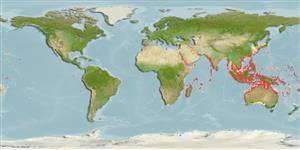Teleostei (teleosts) >
Siluriformes (Catfishes) >
Plotosidae (Eeltail catfishes)
Etymology: Plotosus: Greek, plotos = swimming (Ref. 45335).
Environment: milieu / climate zone / depth range / distribution range
Ecology
Marine; brackish; reef-associated; amphidromous (Ref. 51243); depth range 1 - 60 m (Ref. 37816). Tropical; 38°N - 35°S, 20°E - 169°W
Indo-Pacific: Red Sea and East Africa to Samoa, north to southern Japan, southern Korea, and the Ogasawara Islands, south to Australia and Lord Howe Island. Palau and Yap in Micronesia (Ref. 1602). Sometimes enters freshwaters of East Africa (Lake Malawi) and Madagascar (Ref. 3879). First record in the Mediterranean (Ref. 123740),
Length at first maturity / Size / Weight / Age
Maturity: Lm 16.9 range ? - ? cm
Max length : 35.2 cm TL male/unsexed; (Ref. 127810); common length : 25.0 cm TL male/unsexed; (Ref. 3478); max. reported age: 7 years (Ref. 240)
Dorsal spines (total): 1; Dorsal soft rays (total): 69 - 115; Anal spines: 0; Anal soft rays: 58 - 82. This species has the dorsal and anal fins continuous with caudal fin; with 4 pairs of mouth barbels; and a single highly venomous serrate spine at the beginning of the first dorsal and each of the pectoral fins (Ref. 1602).
Coastal benthic (Ref. 68964). The only catfish found in coral reefs. Also found in estuaries, tide pools and open coasts. Juveniles form dense ball-shaped schools of about 100 fish; adults are solitary or occur in smaller groups of around 20 and are known to hide under ledges during the day (Ref. 1602, 5503, 12693, 37816, 48635). Adults search and stir the sand incessantly for crustaceans, mollusks, worms, and sometimes fish (Ref. 5213). Oviparous, with demersal eggs and planktonic larvae (Ref. 205). The highly venomous serrate spine of the first dorsal and each of the pectoral fins are dangerous, and even fatal in rare cases (Ref. 1602).
The male in the spawning pair constructs the nest under rocks and other large pieces of debris (Ref. 240). After spawning, the female departs while the male guards the eggs.
Taylor, W.R. and J.R. Gomon, 1986. Plotosidae. p. 160-162. In J. Daget, J.-P. Gosse and D.F.E. Thys van den Audenaerde (eds.) Check-list of the freshwater fishes of Africa (CLOFFA). ISBN, Brussels; MRAC, Tervuren; and ORSTOM, Paris. Vol. 2. (Ref. 3879)
IUCN Red List Status (Ref. 130435: Version 2024-2)
Human uses
Fisheries: commercial; aquarium: commercial
Tools
Special reports
Download XML
Internet sources
Estimates based on models
Preferred temperature (Ref.
123201): 24.5 - 29.1, mean 28.1 °C (based on 1536 cells).
Phylogenetic diversity index (Ref.
82804): PD
50 = 0.5020 [Uniqueness, from 0.5 = low to 2.0 = high].
Bayesian length-weight: a=0.00617 (0.00457 - 0.00832), b=3.12 (3.04 - 3.20), in cm total length, based on LWR estimates for this species (Ref.
93245).
Trophic level (Ref.
69278): 3.6 ±0.3 se; based on diet studies.
Resilience (Ref.
120179): Medium, minimum population doubling time 1.4 - 4.4 years (K=0.44-0.45; tm=1-3; tmax=7).
Prior r = 0.57, 95% CL = 0.37 - 0.85, Based on 1 data-limited stock assessment.
Fishing Vulnerability (Ref.
59153): Low to moderate vulnerability (29 of 100).
Nutrients (Ref.
124155): Calcium = 53.1 [24.8, 136.3] mg/100g; Iron = 0.646 [0.386, 1.153] mg/100g; Protein = 17.9 [15.6, 20.2] %; Omega3 = 0.189 [0.101, 0.357] g/100g; Selenium = 31.8 [18.0, 62.1] μg/100g; VitaminA = 80.2 [26.5, 245.0] μg/100g; Zinc = 1.35 [0.94, 1.87] mg/100g (wet weight);
